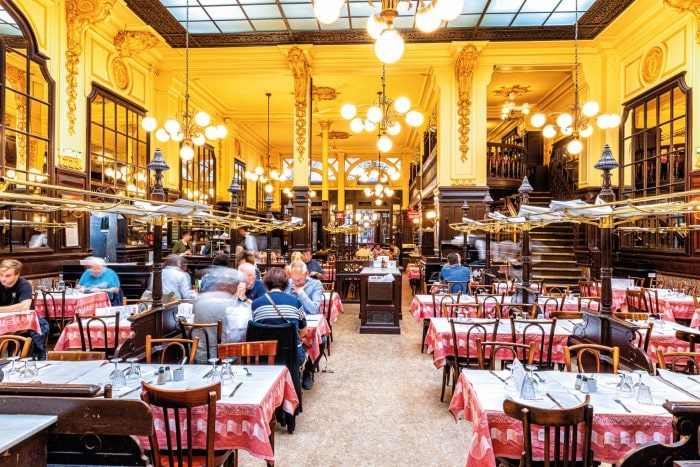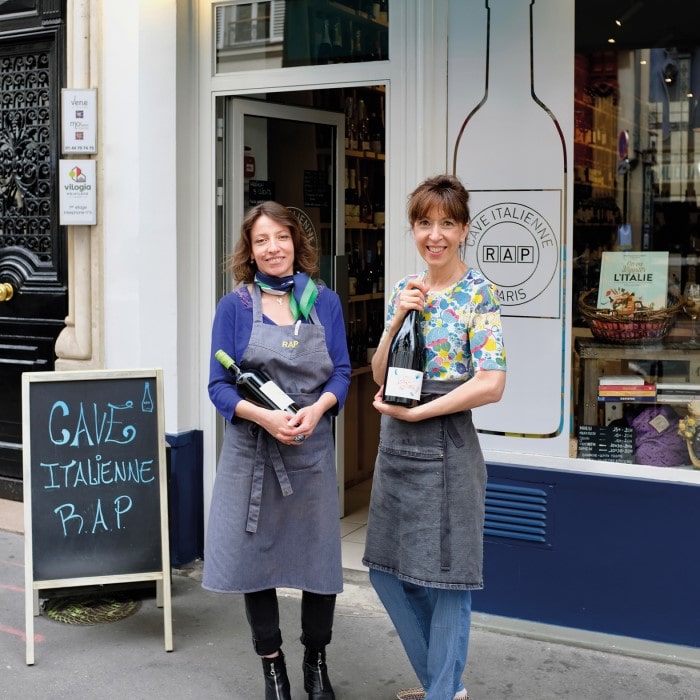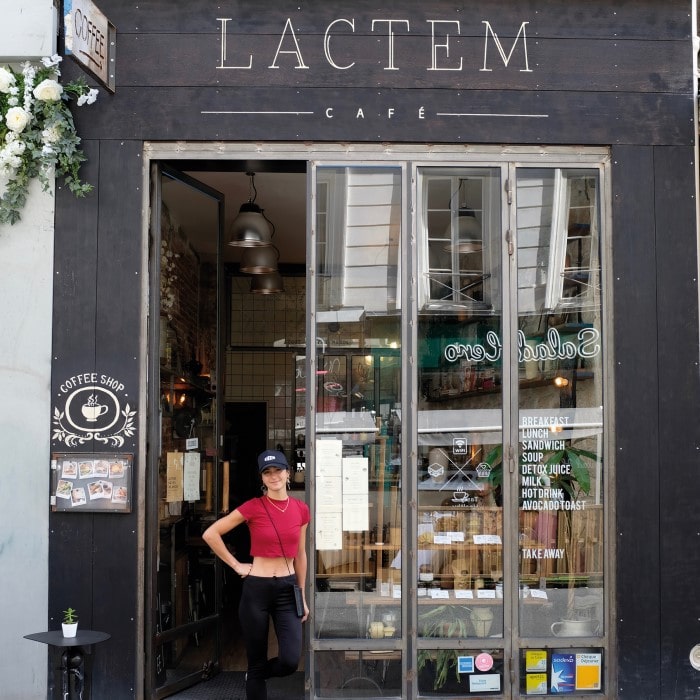Parisian Walkways: Rue du Faubourg-Montmartre

From Belle Époque beauties to bonbons, Jeffrey T Iverson finds Rue du Faubourg Montmartre hits the sweet spot with its heady mix of history and gastronomy.
Paris has a host of ancient streets, but among the most trodden of all is Rue du Faubourg-Montmartre. When the city was taken by the Romans in the late 1st century AD, it was part of a road that extended all the way from Lutetia up to the highest butte, or hill, north of the city. After the Romans arrested the first bishop of Paris, Saint Denis, around 250 AD, for converting the Gauls to Christianity, it was along this road that he would finally be marched to meet the executioner’s sword atop the butte overlooking Paris. As the legend goes, after Saint Denis was beheaded, he casually picked up his head, washed it off in a fountain, and continued his stroll a few kilometres more (all the while delivering a homily to stunned onlookers).
The butte would thereafter be known as Mons Martyrum – literally ‘martyrs’ hill’, or Montmartre. The road leading there from Paris became the Rue de Montmartre, with the section outside the medieval city walls referred to as the Faubourg Montmartre (from the Latin foris, ‘out of’, and burgum, ‘town’ or ‘fortress’). The road thus became a sainted path, and several churches and abbeys would be built along it through the centuries. An enigmatic bas-relief sculpted in the early 1700s depicting the Annunciation to the Virgin Mary still figures on a building at no. 21, purportedly the vestige of a convent that once flourished there. Anticlerical revolutionaries of 1789, clearly conscious of this history, briefly changed the name of the street to Rue du Faubourg Montmarat as a snub to the Church, in honour of the Jacobin icon Jean-Paul Marat.

Cosy coffee shop Lactem serves delicious treats along with some of the best coffee you will find in the capital. © J T IVERSON
Yet despite its symbolic importance, through much of its early history Rue du Faubourg-Montmartre was little more than a means of getting somewhere else. Even now, it’s a street that many visitors to Paris rush by without a second glance, hurrying towards other sites their guidebooks deem more worthy of their attention. And yet there was a time when this street was a destination in its own right, when it was lined with enticing shops, ebullient cafés, and raucous theatres, and some of the greatest artists and writers of the 19th century lived, worked and played here. Today, with the opening of several delectable new addresses – and the revival of a number of historic ones – Rue du Faubourg Montmartre is becoming a destination once again.
If Rue du Faubourg-Montmartre is on the rise today, it’s thanks in part to its location in the heart of Paris’s right bank. Running 635m through the 9th arrondissement between the métro stops Grands Boulevards and Notre-Dame-de-Lorette, the street is walking distance from numerous landmarks, be it the Louvre, Sacré-Cœur or the Pompidou. Which is probably why the 9th counts the most hotels of any district in Paris – 184 at the last census. Rue du Faubourg Montmartre abounds with attractive lodgings, from recent openings like the Walled Off Hotel at no. 44 (a reproduction of Banksy’s art hotel in Israel) and Monsieur Cadet (a stylish, Art-Deco boutique hotel just around the corner on Rue Cadet), to the numerous venerable hotels that line the street’s serene passageway, La Cité Bergère.

Sweet treats at À la Mère de Famille © J T IVERSON
Built in 1825, La Cité Bergère is where Frédéric Chopin rented a room (at no. 4) for a year in the 1830s, the period when the Polish pianist fell in love with Paris – and with George Sand. The writer Isidore ‘Le Comte de Lautréamont’ Ducasse, who later became the posthumous patron saint for the Surrealists movement, spent his most productive days on Rue du Faubourg Montmartre, living at no. 32 and no. 7, where he died in 1870 just days after publishing his final book of poems. Heinrich Heine, a German poet whose lyric poetry was set to music by composers such as Schumann and Schubert, moved into no. 3 La Cité Bergère in 1836 after meeting his future wife, Mathilde, in the nearby Passage des Panoramas. Ten years later, he’d write, “If I die in Paris, I want to be buried in the cemetery of Montmartre, and no other, for it was among the people of Faubourg-Montmartre that I lived the dearest moments of my life”.
Life on Rue du Faubourg-Montmartre may never again compare to the heady years of the Belle Époque, but over the last decade it has undeniably begun to regain its lustre. One herald of the street’s revival came in 2018 with the opening of Lactem (no. 58), a fresh-faced café that’s helping change the image of coffee in Paris. At her cosy, chic coffee shop, Hoëlle Jego brews up perfect lattés with avocado toast brunches and generous vegan desserts. “My generation has developed a taste for speciality coffee travelling in places like London and New York,” she says. “Which is why today there’s a growing coffee shop culture in Paris.”
Next door, the owners of the enchanting artisan jewellery shop Eiden (no. 58), Sonia Catouaria and Emilie Leon, were thrilled by Hoëlle’s arrival. “Until a few years ago you’d never have imagined a place like Lactem opening on Rue du Faubourg-Montmartre,” says Emilie. “She’s bringing something new to the neighbourhood, and that helps other businesses like ours, since the dynamism of our boutique depends so much on that of the street.”

The street is enjoying a rebirth. © J T IVERSON
Yet neither Hoëlle nor Emilie and Sonia initially imagined themselves here. “We were attracted to Rue des Martyrs at first, only it’s become very expensive,” says Emilie. “But then we found this space free just down the road on Rue du Faubourg-Montmartre, and soon realised that it was a street in the midst of a total transformation, both in terms of food and restaurant offerings, but also in terms of its boutiques.” With plenty of office buildings and hotels, the area offers abundant foot traffic for sure, but Emilie believes it’s the locals who are truly driving the changes. “This area is full of families and people who really love their neighbourhood. They’ve come here because they’re bon vivants, they like to eat well and go to restaurants, they enjoy shopping and a night on the town.”
GASTRONOMIC DELIGHTS
One person keeping this hedonistic population content is Alessandra Pierini, founder of RAP, the city’s greatest Italian delicatessen, straddling the northern tip of Rue du Faubourg-Montmartre at no. 4 Rue Fléchier. Boasting a cornucopia of Italy’s finest artisan foods, Pierini can generate an epicurean stampede with a single Instagram post announcing a new shipment of Bronte pistachios from Sicily or Piennolo del Vesuvio grape tomatoes from Naples. “People are so excited when we get a new arrival,” she says. “It makes this a joyous place to spend my days. For a long time this was primarily known as an artistic neighbourhood, for its theatres and art galleries around the Drouot auction house, but today it’s increasingly becoming a gastronomic one too.”

Dining at Bouillon Chartier is a must. © J T IVERSON
After tasting Alessandra’s farmhouse mozzarella di bufala and rare Neapolitan Caciocavallo, one can continue the cheese feast just down the street with an entire meal of dairy delights at Monbleu (no. 37). A hybrid cheese shop and restaurant that puts fromage at the centre of the plate, Monbleu is the creation of Damien Richardot, a child of the Alps who fell under the charms of the 9th district of Paris and decided to launch his project here in 2017 to shake up the French cheese world. Now Parisians and tourists alike come here for the chance to indulge in a plate of luscious artisan cheeses matched with great charcuterie, wines and veggies on a lively street terrace at the heart of Paris. “People arrive here and have the feeling that they’ve discovered a place that’s a little bit hidden, that’s not flooded with tourists yet has its own attractions,” he says. “They tell themselves, ‘This may not be in my guide, but I’m stopping here anyway!’.”
Monbleu sits on a charming crossroads indeed, with the colourful market street Rue Cadet starting across the way, and the street’s most emblematic shop just next door at no. 35 – A la Mère de Famille, a confections and chocolate maker beloved by gourmands since 1761. Stepping inside is a transporting experience, so little has the interior changed since the 19th century. The Dolfi family, which acquired the shop in 2000, has worked to preserve its warm and inviting spirit, a rare thing today in a city full of sterile, ultra-modern chocolate shops. “We want anyone who walks into our shop to feel welcome – we’re not selling jewels after all!” says co-owner Steve Dolfi. “Meanwhile, we just focus on the quality of our chocolate, and on all the things which we want to preserve here, like our selection of more than a thousand types of sweets. People come to our shop to buy candies that they ate when they were 10 years old, and we never want that to change.”

While away the hours at a pavement café. © J T IVERSON
This mix of new and old is precisely what makes Rue du Faubourg-Montmartre so intriguing today. Window gaze at artists restoring time-worn tableaux at the Atelier de Drouot workshop (no. 45), or see an exhibition of works by street artist Banksy at Espace Lafayette-Drouot (until December 31, 2022). Discover the street’s costume shops, carriers of a tradition going back a century to when Raymond Pontet, once the most famous wigmaker in the Paris theatre world, had his workshops at no. 8. Enjoy an apéritif at Salina, a fabulous seafood eatery that was a poissonnerie in the 19th century, and is now classified as a historic monument for its breathtaking Hokusaï-inspired décor of Sarreguemines ceramic wall tiles. Catch a show at Théâtre du Nord-Ouest (no. 13), formerly the Club des Cinq cabaret where Edith Piaf met the love of her life, boxer Marcel Cerdan.
HISTORIC RESTAURANT
If one had to pick Rue du Faubourg-Montmartre’s quintessential address, though, it would be Bouillon Chartier at no. 7. Founded in 1896 as a workers’ cafeteria, clients came here daily for hearty, inexpensive meals, storing their cloth napkins in numbered drawers that still line the walls. Today, tasting this authentic cuisine and watching the ballet of waiters in their black waistcoats and white aprons under the soaring ceiling of the Belle Époque dining room is a spectacle every lover of City of the Light must experience. “It’s part of Paris today,” says Chartier’s proud directrice, Nathalie Godeau. “Like the Eiffel Tower or Sacré-Coeur, Bouillon Chartier is one of the city’s great monuments.” Open 365 days a year, Chartier had hardly ever closed in its history until Covid forced its doors shut for 10 long months. “It was so strange when we reopened,” says Nathalie. “I’d never heard such silence here before. But when the restaurant started to fill up, it was magnificent. It was like Chartier had dozed off for a time, and then suddenly it woke up and just sprang back to life exactly as it was before.” More than a restaurant, Chartier is a bastion of living history, and reason alone to come witness the reawakening of this ancient and alluring street.
RESTAURANTS AND BOUTIQUES
RAP DELICATESSEN
4 rue Fléchier
Tel. +33 1 42 80 09 91
In Paris, RAP is known simply as the mecca of Italian gastronomy. Alessandra Pierini has scoured her country for 30 years to find the greatest artisan producers, and this delicatessen represents her most delicious discoveries. Her farmhouse mozzarella, mouthwatering hams and mortadella, Bronte pistachios, and even just her pasta, olive oil, balsamic vinegar, or tomatoes, are pure delights. A must for epicureans!

RAP Cave Italienne © J T IVERSON
RAP CAVE ITALIENNE
61 Rue du Faubourg-Montmartre
Tel. +33 1 42 00 09 55
For years, Alessandra Pierini defended Italian artisan wine at her renowned delicatessen RAP, working to erase the old image of bad Chianti in straw-covered bottles. But frustrated by her shop’s limited space, she decided to open what is today undoubtedly the greatest Italian wine shop in Paris. This vast collection of wines represents a veritable tour of Italy’s terroirs and 600 grape varieties.
LACTEM CAFÉ
58 Rue du Faubourg-Montmartre
Tel. +33 9 86 36 71 26
Speciality coffee culture is conquering Paris today, thanks to charming, cosy, chic coffee shops like Lactem. Owner Hoëlle Jego matches delicious vegetarian brunches and indulgent pastries (like ultra thick, ultra moist vegan peanut-butter chocolate-chip cookies) with perfect lattés, made with coffee from Lomi, the Parisian company founded by pioneering Australian coffee roaster Paul Arnephy.

Lactem © J T IVERSON
MONBLEU
37 Rue du Faubourg-Montmartre
Tel. +33 1 45 89 23 96
France can be criticised for lacking innovative spirit to match its proud gastronomic traditions, yet Monbleu brings a whole new approach to the country’s most beloved food – cheese. Equal parts cheese shop and restaurant, Monbleu sells exceptional artisan cheeses to go, and serves them straight up and in lovely cooked dishes with great artisan wines and charcuterie in a chic, relaxed space.

A la Mere de Famille famille © Yann Deret
À LA MÈRE DE FAMILLE
35 Rue du Faubourg-Montmartre
Tel. +33 1 47 70 83 69
Its historic façade, offering desserts, vin fins, and fruits confits, is one of the most renowned in Paris. Founded 260 years ago in 1761, À la Mère de Famille is the city’s oldest sweetshop. Its cornucopia of delights represents the confectionery history of France, from almond dragées, marrons glacés, and calissons de Provence, to violet bonbons, Nevers caramels, and exquisite Palet Montmartre chocolates.
BOUILLON CHARTIER
7 Rue du Faubourg-Montmartre
Tel. +33 1 47 70 86 29
Founded in 1896 and named after the restorative soup it once served the working classes, Bouillon Chartier is a true Parisian monument. Steeped in tradition, Chartier’s authentic French dishes (and low prices!) have changed as little as the stunning, historic décor. With its savoury cuisine and ebullient ambiance of another era, it’s a restaurant that transports you back to the Belle Époque.
From France Today magazine
Share to: Facebook Twitter LinkedIn Email
More in French food, gastronomy, paris food, restaurants
Leave a reply
Your email address will not be published. Required fields are marked *



